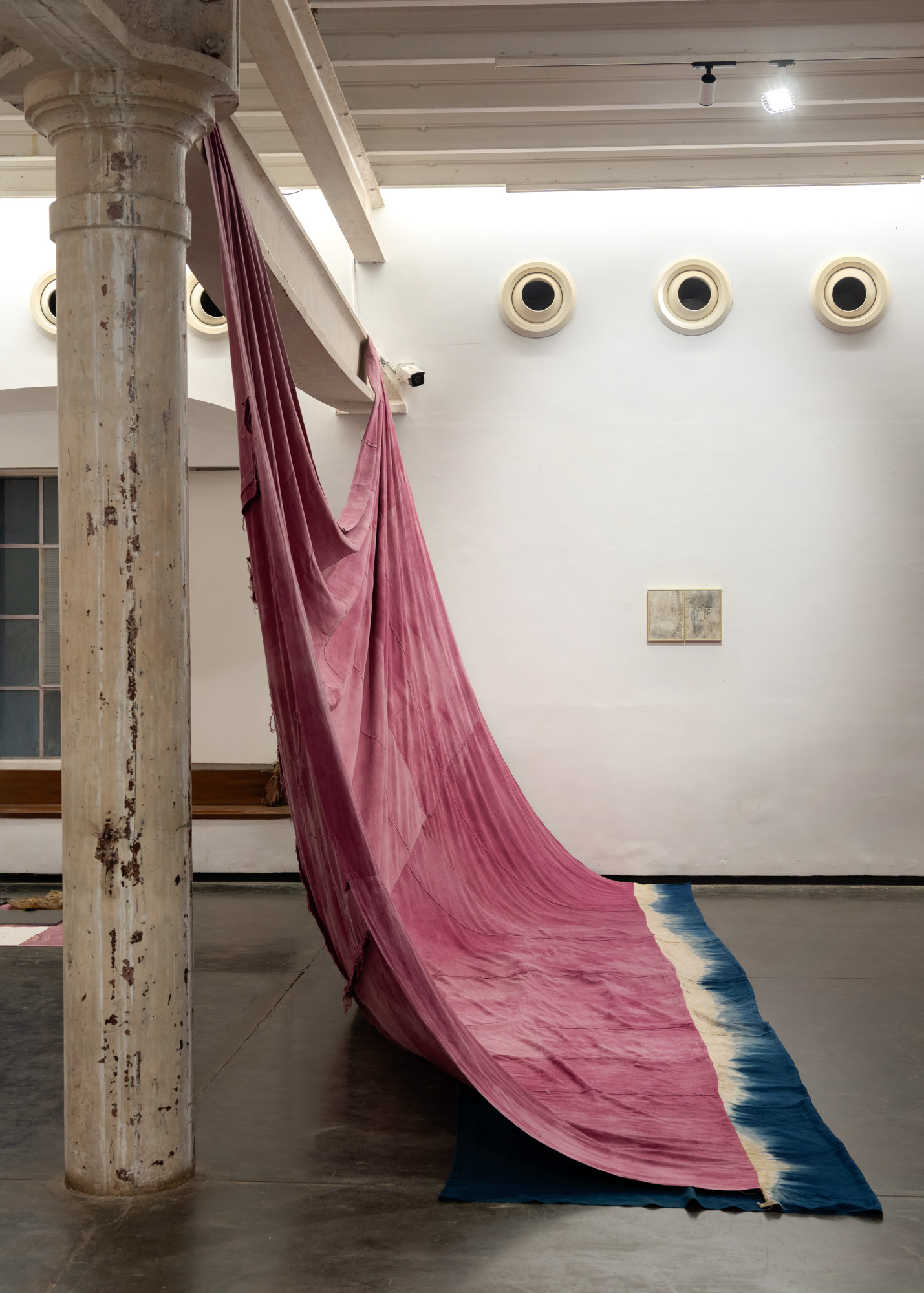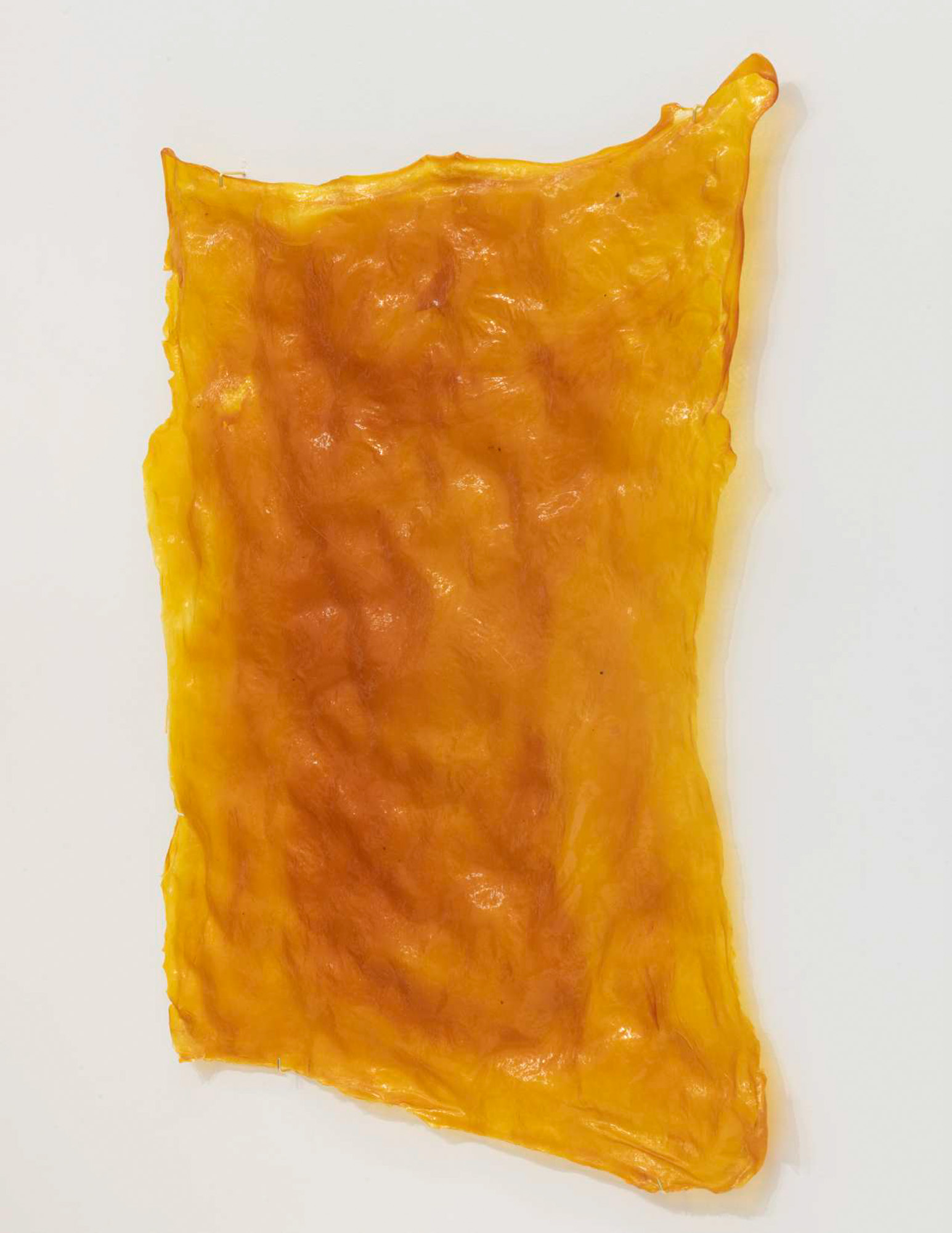Temporalities and Memories: Hemali Bhuta’s “Aha!”
By Meera Menezes

Installation view of HEMALI BHUTA’s "Aha!" at Project 88, Mumbai, 2022. All images courtesy the artist and Project 88.
The title of Hemali Bhuta’s show “Aha!,” mounted at Mumbai’s Project88, could allude to an eureka moment—perhaps it was an expression of the artist’s sheer wonder and delight at orchestrating three of her previous shows into one. Bhuta’s latest solo exhibition comprised artworks from prior ones: “Measure of a foot” (2016), “Subarnarekha” (2017), as well as “and the epic did not happen!”(2021). Eschewing a linear narrative, she unearthed and placed earlier works in new constellations in her installation A Shrine (2022).
Process is integral to Bhuta’s practice. To create many of her fabric works from “and the epic did not happen!,” the artist traveled through villages in the eastern Indian state of Jharkhand to witness the arduous process of making lac—a resin secreted by the female lac insect on twigs and branches. Collecting the long strips of porous cloth used in the extraction of this resin, Bhuta then painstakingly boiled, ironed, and stitched them together to fashion her artwork.

Installation view of HEMALI BHUTA’s A Shrine, 2022, multimedia installation, dimensions variable, at "Aha!," Project 88, Mumbai, 2022.
“Aha!” opened with one of Bhuta’s lac-based works, A craziness fills my mind (2021), a large expanse of lac-stained fabric draped across a chord, spilling onto the floor. Elsewhere, In this world of the familiar I search for the unknown in wonder my song bursts forth (2021) features a sheet of reddish lac-dyed Bengal khadi cotton, composed of seemingly hand-stitched squares, which turns briefly white before bleeding into a swathe of indigo blue. Both of these works served as a testament to Bhuta’s meticulous, manual process. Perhaps the folding and unfolding of the fabric is a metaphor for time turning on itself or its very unravelling.
Bhuta’s preoccupation with artistic labor manifested in her works From the Pile (2017) and Encounters with Gold (2017), which were also part of her earlier show “Subarnarekha” staged at the Centre international d’art et du paysage de Vassivière in France in 2017. The title of that show was derived from the eponymously named river, which flows through Jharkhand and means “streak of gold.” Legend has it that gold could be found in the river bed, and the artist’s deep-seated interest in locating the origins of her material led her to try panning for gold at the river. These experiences culminated in the creation of Encounters with Gold, where gold was used in its zari and gold leaf form.

Installation view of HEMALI BHUTA’s In this world of the familiar I search for the unknown In wonder my songs bursts forth, 2021, lac dye, indigo dye, dye from dried leaves of tress on Bengal khadi cotton, 550 × 550 cm, at "Aha!," Project 88, Mumbai, 2022.
Another demonstration of the detailed process integral to the artist’s practice was a body of textile works referencing the vegetal world. While cyanotypes on cotton such as The fragrance of the flowers lifts my soul (2021) served as an archive of the foliage that the artist had nurtured in Mumbai, A gift (2021) is a series of eco-prints of plants from the CONA garden in Goa, the state where the artist moved to during the pandemic.

HEMALI BHUTA, In the midst of this, I find my place, 2021, hand made shellac of different shades, 78.7 × 58.4 cm.
Through her labor-intensive process, she plumbs the potentiality of each material, presenting them to viewers in different states of being and becoming. For instance, in On the bosom of the earth I pour my soul (2021), lac buttons were hand ground with mortar and pestle at the artist’s studio, while In the midst of this, I find my place (2021) comprises undulating and uneven sheets of handmade shellac piled atop each other. These also served as a testimony to the physical labor involved in traditionally stretching the sheets with the various limbs of the body.
“Aha!” came as a revelation not only of the temporalities and memories that lie embedded in materials, but also of the serendipitous possibilities for their transformation. By offering glimpses into the processes that underpinned her artworks, Bhuta subtly pointed to the role of time and memory in the creation of the material world.






